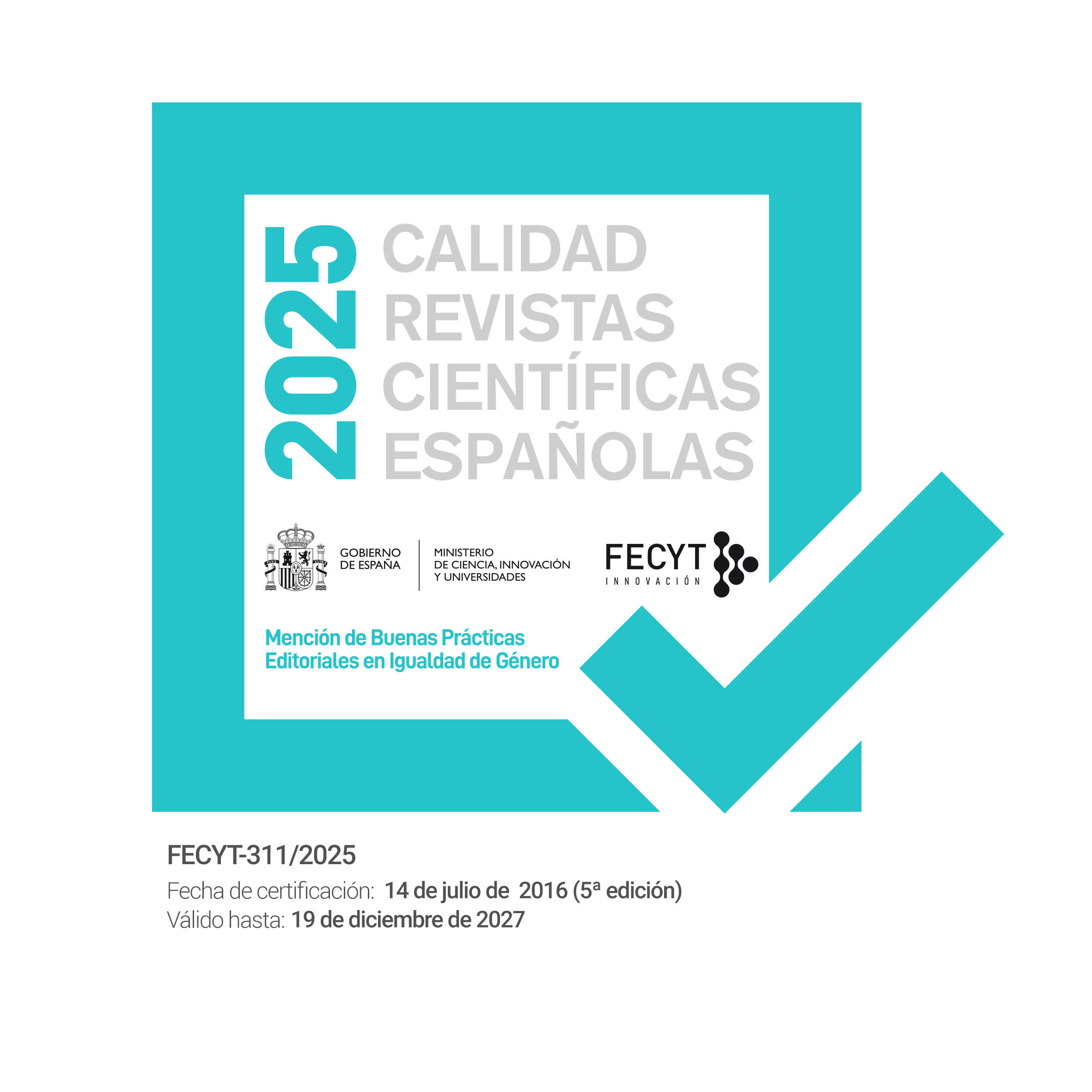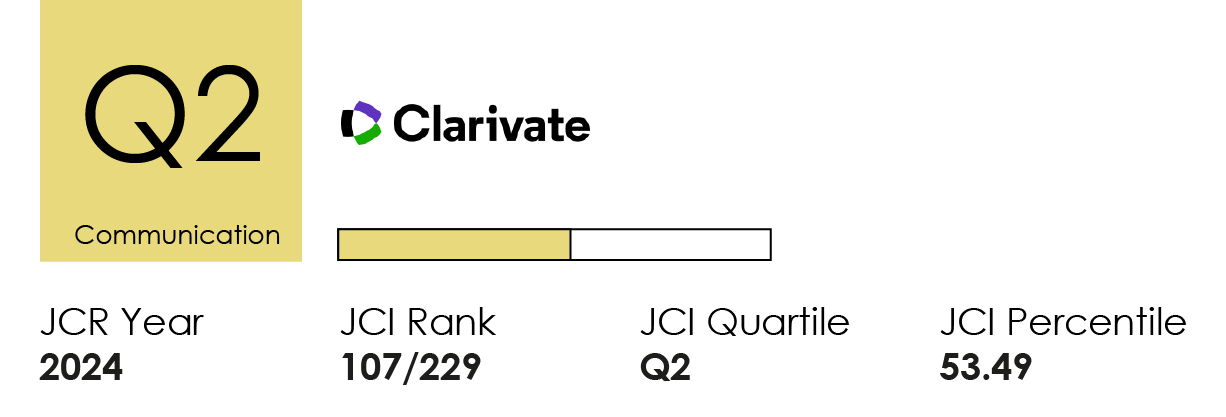Valores morales, empatía e identificación con los personajes de ficción. El universo representativo de “Cuéntame cómo pasó” (TVE)
DOI:
https://doi.org/10.14198/MEDCOM2012.3.10Palabras clave:
Valores morales, Televisión, Sociología, Problemas socialesResumen
En la presente investigación se muestran los resultados de un estudio de base experimental sobre el análisis de los valores morales presentes en la serie emitida por Televisión Española “Cuéntame cómo pasó”. La discusión se centra en los valores morales como el aspecto nuclear de este constructo audiovisual, en especial en su posible correlación con la identificación de los personajes y la empatía ficcional del formato. En el estudio participaron 47 estudiantes universitarios y 36 personas de más edad, quienes fueron sometidos a unos cuestionarios analíticos anteriores y posteriores al visionado de dos capítulos de la serie televisiva. Tras la aplicación pre-test y post-test de la Escala de Comportamientos Morales Controvertidos, y las escalas EDI (Identificación con los personajes de relatos audiovisuales de ficción) e IRI (Interpersonal Reactivity Index), se revela que aunque el sexo y la edad no son factores explicativos, el visionado del capítulo de ficción es capaz de provocar un cambio en la escala moral en los sujetos.
Citas
Althusser, L., (1971): “Ideology and the State”. Lenin & Philosophy and Other Essays. New Left Books.
Basil, Michael D. (1996): “Identification as a mediator of celebrity effects”. Journal of Broadcasting and Electronic Media, vol. 40, nº 4, p. 478-495.
Baxter, Leslie A. y Babbie, Earl (2004): The basics of communication research, Thomson Wadsworth, Toronto.
Bryant, Jennings y Vorderer, Peter. (2006): Psychology of entertainment, Lawrence Erlbaum Associates, Mahwah, NJ, 2006; Tannenbaum, Percy H., The entertainment functions of television, Lawrence Erlbaum Associates, Hillsdale, NJ.
Calvert, S. L., Murray, K. J. y Conger, E. E. (2004): “Heroic DVD portrayals: what US and Taiwanese adolescents admire and understand”. Applied Developmental Psychology, 25, p.699-716.
Calvert, S. L., Strouse, G. A. y Murray, K. J. (2006): “Empathy for adolescents’ role model selection and learning of DVD content”. Applied Developmental Psychology, 27, p.444-455.
Chory-Assad, R. M. y Cicchirillo, V. (2005): “Empathy and affective orientation as predictors of identificacion with television characters”. Communication Research Reports, 22 (2), p.151-156.
Cliffordson, C. (2001): “Parent’s judgments and student’s self-judgments of Empathy”. European Journal of Psychological Assessment, 17, p.36-47.
Cohen, J. (2001): “Defining identification: a theoretical look at the identification of audiences with media characters”. Mass Communication and Society, 4 (3), p.245- 264.
Cohen, J. (2006): “Audience identification with media characters”. En J. Bryant y P. Vorderer (Eds.), Psychology of entertainment (pp. 183-197). Mahwah, NJ: Lawrence Erlbaum Associates.
Davis, M.H. (1980): “A multidimensional approach to individual differences in empathy”. Catalog of Selected Documents in Psychology, 10, 85, p. 1-17.
Davis, M.H. (1983): “Measuring individual differences in empathy: Evidence for a multidimensional approach”. Journal of Personality and Social Psychology, 44, p. 113-126.
Davis, M.H.(1996): Empathy. A social psychological approach. Boulder, CO: Westview Press.
Davis, Mark H., Hull, Jay G., Young, Richard D. y Warren, Gregory G. (1987): “Emotional reactions to dramatic film stimuli: the influence of cognitive and emotional empathy”. Journal of Personality and Social Psychology, vol. 52 nº 1, p. 126-133.
De Toda, J.M. (1998): “El impacto moral y social de los medios de comunicación social”. Comunicar, nº 10, p. 164-170.
De Wied, Minet, Zillmann, Dolf y Ordman, Virginia. (1994): “The role of empathic distress in the enjoyment of cinematic tragedy”. Poetics, vol. 23, p. 91-1006.
Eyal, K. y Rubin, A. M. (2003): “Viewer aggression and homophily, identification, and parasocial relationships with television characters”. Journal of Broadcasting and Electronic Media, 47 (1), p. 77-98.
Freud, Sigmund (1985): Psicoanálisis del arte. Alianza Editorial, Madrid.
García De Castro, M. (2008): “Los movimientos de renovación en las series televisivas españolas”. Comunicar, nº30, p. 147-153.
Gómez, A. (2006): “Conducta de ayuda, conducta prosocial y altruismo”. En A. Gómez, E. Gaviria e I. Fernández (Coords.), Psicología social (p. 329- 390). Madrid: Editorial Sanz y Torres.
González, Belén (2008): “Del Pater Familias al Pater Erectus: (in)visibilidad y crisis del paternalismo en Cuéntame cómo pasó”. Revista Garoza, nº 8, p. 173-182.
Harding, S y Phillips, D. (1986): “The Morally Debatable Behaviors Escale”. En J. Robinson, P. Shaver y L. Wrightsman, Measures of personality and social psychological attitudes. Vol 1, San Diego, C.A, p. 742-46.
Heiskanen, I. (2001): Descentralization: trends in european cultural policies. Strasbourg, Council of Europe.
Hoffner, C. y Cantor, J. (1991): “Perceiving and responding to mass media characters”. En J. Bryant y D. Zillmann (Eds.), Reponding to the Screen. Reception and Reaction Processes (p. 63-102). Hillsdale, NJ: Lawrence Erlbaum Associates.
Hoffner, Cynthia. (1996): “Children’s wishful identification and parasocial interaction with favourite televisión characters”. Journal of Broadcasting and Electronic Media, vol. 40, nº 3, p. 389-402.
Hoffner, Cynthia y Buchanan, Martha. (2005): “Young adults wishful identification with televisión characters: the role of perceived similarity and character attributes”, Media Psychology, vol. 7, p. 325-351.
Hogan, R. (1969): “Development of an Empathy Scale”. Journal of Consulting and Clinical Psychology, 33, p. 307-316.
Igartua, Juan José y Páez, Darío. (1997a): “Art and remembering traumatic collective events: The case of the Spanish Civil War”. En Pennebaker, J., Páez, D. y Rimé, B. (eds.), Collective memory of political event. Social psychological perspectives, Lawrence Erlbaum Associates, Mahwah, NJ, p. 79-101.
Igartua, Juan José y Páez, Darío. (1997b): “El cine sobre la Guerra Civil Española. Una investigación sobre su impacto en actitudes y creencias”. Boletín de Psicología, vol. 57, p. 7-39.
Igartua, Juan José y Páez, Darío. (1998): “Fiabilidad y validez de una escala de empatía e identificación con los personajes». Psicothema, vol. X, nº 2, p. 423-436.
Igartua, Juan José (2006): “Métodos cuantitativos de investigación en comunicación». Bosch, Barcelona.
Igartua, Juan José y Muñiz, Carlos (2008): “Identificación con los personajes y disfrute ante largometrajes de ficción. Una investigación empírica”. Comunicación y Sociedad, Vol. 21, Núm. 1, p. 25-52.
Igartua, Juan-José; Acosta, Tania y Frutos, Francisco. J. (2009): “Recepción e impacto del drama cinematográfico: el papel de la identificación con los personajes y la empatía”. Global Media Journal Edición Iberoamericana, Vol. 6, Número 11, p. 1-18.
Kohlberg, L. (1992): Psicología del desarrollo moral. Bilbao. Desclée de Brower.
Konijn, Elly A. y Hoorn, Johan F. (2005): “Some like it bad: testing a model for perceiving and experiencing fictional characters”. Media Psychology, vol. 7, nº 2, p. 104-144.
Linde, A. (2008): “La TV como medio de educación moral para la ciudadanía democrática”. Comunicar, nº 31, p. 51-56.
Martín, S. (2005): “La heroína limitada”. Lectora, p. 115-130.
Maccoby, E. y Wilson, W. C. (1957): “Identification and observational learning from films”. Journal of Abnormal and Social Psychology, 55, p. 76-87.
Mathiesen, M.; Mora, O.; Chamblás, I. y Navarro, G. (2004): “Familia, permisividad y juicio moral en estudiantes de enseñanza media de la provincia de Concepción”. Psykhe. 13(1), p. 3-20.
Medrano, C y Aierbe, A. (2008): “Valores y contexto de desarrollo”. Revista de Psicodidáctica. Vol 13, nº1, p.53-67.
Medrano, C; Corté, P; y Palacios, S. (2007). “La televisión y el desarrollo de valores”. Revista de educación, nº 342, pp.307-328.
Mehrabian, A. y Epstein, N. (1972): “A measure of emotional empathy”. Journal of Personality, nº 40, p. 525-543.
Merino, S.C. y Grimaldo M. M. (2010): “Complejidad factorial de la permisividad moral hacia las conductas morales controvertidas”. Interdisplinaria. Vol 27, nº 2, pp: 297-314.
Metz, Christian (1982): The imaginary signifier. Psychoanalysis and cinema. Indiana University Press, Bloomington, IN.
Nathanson, Amy I. (2003): “Rethinking empathy”. En Bryant, J., Roskos-Ewoldsen, D. y Cantor, J.R. (eds.), Communication and emotion. Essays in honor of Dolf Zillmann, Lawrence Erlbaum Associates, Mahwah, NJ, p. 107-130.
Oatley, Keith (1994): “A taxonomy of the emotions of literary response and a theory of identification in fictional narrative”. Poetics, vol. 23, p. 53-74.
Oatley, Keith (1999): “Meeting of minds: dialogue, sympathy and identification in reading fiction”. Poetics, vol. 26, p. 439-454.
Oatley, Keith(2002): “Emotions and the story worlds of fiction”. En Green, M.C., Strange, J.J. y Brock, T.C. (eds.), Narrative impact. Social and cognitive foundations, Lawrence Erlbaum Associates, Mahwah, NJ, p. 39-69.
Oliver, M.B: (2008): “Tender affective states as predictors of entertainment preferences”. Journal of Communication, 58 (1), 40-61.
Oliver, M. B. y Raney, A. (2008): “Development of hedonic and eudaimonic measures of entertainment motivations: the role of affective and cognitive gratifications”. The 58th Annual Conference of the International Communication Association. Del 22-26 mayo. Montreal. Canadá.
Paraíso, Isabel (1994): Psicoanálisis de la experiencia literaria. Cátedra, Madrid.
Pérez-Albéniz, A; De Paul, J; Etxebarría, J; Montes, M.P; Torres, E. (2003): “Adaptación de Interpersonal Reactivity Index (IRI) al español”. Psicothema. Vol. 15, nº 2, p. 267-272.
Poulantzas, N. (1975): Classes in Contemporaty Capitalism. NLB. London, p. 25.
Robinson, J.; Shaver P. y Wrightsman, L. (1991): Measures of personality and social psychological attitudes.
San Diego, CA: Academic Press.
Slater, M. D. y Rouner, D. (2002): “Entertainment-education and elaboration likelihood: understanding the processing of narrative persuasion”. Communication Theory, 12 (2), p. 173-191.
Slater, M. D., Rouner, D. y Long, M. (2006): “Television dramas and support for controversial public policies: effects and mechanisms”. Journal of Communication, 56, p. 235-252.
Tannenbaum, Percy H. y Gaer, Eleanor P. (1965): “Mood change as a function of stress of protagonist and degree of identification in a film-viewing situation”. Journal of Personality and Social Psychology, vol. II, nº 4, p. 612-616.
Thornham, S y Purvis, T. (2005): Television drama. Theories and identities. New York. Palgrave, MacMillan.
Turner, Charles W.y Berkowitz, Leonard. (1972): “Identification with aggressor (cover role taking) and reactions to film violence”. Journal of Personality and Social Psychology, vol. 21, nº 2, p. 256-264.
Viemero, V. (1986): Relationships between Filmed Violence and Aggression. Tesis Doctoral. Abo Akademi, Finland.
Wartella, E. y Reeves, B. (1987): Communication and Children. Berger & Chaffee (Eds.): Handbook of Communication Science. Sage.
White, R.A. (1994): “Audience Interpretation of Media: Emerging Perspectives”. Communication Research Trends, 3; vol. 14. CSCC. St. Louis (EEUU).
Wiio, O.A. (1994): TV: Guilty or not Guilty? Television and Violence: an International Comparison.
Finland, University of Helsinki.
Zillmann, Dolf. (1994): “Mechanisms of emotional involvement with drama”. Poetics, vol. 23, p. 33-51.
Zillmann, Dolf y Cantor, Joanne R. (1977): “Affective responses to the emotions of a protagonist”. Journal Experimental Social Psychology, vol. XIII, p. 155-165.
Zillmann, Dolf (1991): “Empathy: affect from bearing witness to the emotions of Others”. En Bryant, J. y Zillmann, D. (eds.), Responding to the screen. Reception and reaction processes, Lawrence Erlbaum Associates, Hillsdale, NJ, p. 135-167.
Zumalde, I. (2011): “La emoción fílmica. Un análisis comparativo de las teorías cinematográficas”. Revista Latina de Comunicación Social, nº 66, p. 326-249.
Zunzunegui, Santos. (1989): Pensar la imagen. Cátedra, Madrid.
Descargas
Estadísticas
Publicado
Cómo citar
Número
Sección
Licencia
Derechos de autor 2012 Sebastián Sánchez-Castillo

Esta obra está bajo una licencia internacional Creative Commons Atribución-CompartirIgual 4.0.
Los autores y autoras que publican en esta revista están de acuerdo con los siguientes términos:
1 Derechos de autor. Los autores y autoras conservan sus derechos de autor, aunque ceden a la revista de forma no exclusiva los derechos de explotación (reproducción, distribución, comunicación pública y transformación) y garantizan a esta el derecho de primera publicación de su trabajo, el cual estará simultáneamente sujeto a la licencia indicada en punto 2. Los autores pueden establecer otros acuerdos adicionales para la distribución no exclusiva de la versión de la obra publicada en la revista, siempre que exista un reconocimiento de su publicación inicial en esta revista.
© Los autores.
2 Licencia. Los trabajos se publican en la revista sujetos a la licencia de Reconocimiento 4.0 Internacional de Creative Commons (CC BY 4.0); los términos se pueden consultar en https://creativecommons.org/licenses/by/4.0/
Esta licencia permite a terceros compartir (copiar y redistribuir el material en cualquier medio o formato) y adaptar (remezclar, transformar y crear a partir del material para cualquier finalidad, incluso comercial), siempre que se reconozca la autoría y la primera publicación en esta revista (Revista Mediterránea de Comunicación (RMC) / Mediterranean Journal of Communication (MJC), Universidad de Alicante, DOI de la obra), se proporcione un enlace a la licencia y se indique si se han realizado cambios en la obra.
3 Política de autoarchivo. Se recomienda a los autores que difundan sus trabajos a través de Internet para favorecer una circulación y difusión más rápidas y, con ello, un posible aumento en la citación y alcance entre la comunidad científica y académica, en las siguientes condiciones:
No se permite a los autores depositar en un repositorio institucional o temático, página web propia, etc., las versiones preprint (versión antes de ser evaluada) o postprint (versión evaluada y aceptada para su publicación) de sus trabajos antes de su publicación, pero sí el artículo final publicado (versión del editor).













